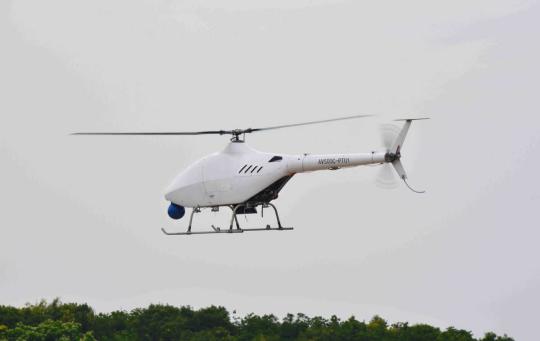
The AR500C unmanned helicopter is tested in Jingdezhen, Jiangxi province, last month. (PHOTO PROVIDED TO CHINA DAILY)
China's first unmanned helicopter specifically designed for plateau conditions recently conducted its maiden flight, according to the model's developer, Aviation Industry Corp of China, the country's leading aircraft conglomerate.
The AR500C, designed and built by the AVIC Helicopter Research and Development Institute in Jingdezhen, Jiangxi province, took off for the first time on May 20 at the institute's unmanned aircraft testing base in Jiangxi's Poyang county and stayed in the air for about 20 minutes.
It made several maneuvers during the flight and produced "satisfactory data", AVIC said in a statement.
The company said the model was designed based on its predecessor, the AR500B, and in accordance with plateau environments. It has been tasked with undertaking information support operations such as reconnaissance and signal relay, it added.
Fang Yonghong, technology director at the institute, said the AR500C has a maximum takeoff weight of 500 kilograms, a flight ceiling of 6,700 meters and a maximum speed of 170 kilometers per hour. It can stay in the air for five hours during an operation and can make autonomous takeoffs and landings.
The unmanned rotorcraft can carry additional equipment to carry out various tasks such as electronic jamming, aerial search, fire suppression, maritime surveillance as well as tracing for nuclear or chemical leaks. It can also cooperate with manned aircraft or independently operate in target locking and strike, and supply transportation, he said.
The institute started research and development on the AR500C last year with designers focusing on its engine, rotor wing, aerodynamic modifications and composite materials. The first one was assembled in March and then began to undergo ground tests before the flight test, according to Fang.
AVIC developed several types of unmanned helicopters, but they were not specifically designed for plateau deployment.
Wu Peixin, an aviation industry observer in Beijing, explained that the special environmental conditions on plateau, ranging from low oxygen levels to chilly temperatures and rapidly changing weather, pose big challenges to aircraft.
Compared with conventional unmanned helicopters, those made for plateau operations should have stronger engines, better temperature adaptability and other specific modifications, he said, adding that they will be very useful in China.

- China conducts first flight test for domestically developed reusable liquid rocket engine
- Comprehensive inspection train performs test along high-speed railway in S China’s Guangxi
- AC352 helicopter cleared to enter market
- New utility helicopter cleared to enter market
- C919 jet nears certification, expected to enter commercial flight in 2023
- Self-developed airplane by Hubei company makes maiden flight
Popular Videos
Hot comments
- First apes at U.S. zoo receive COVID-19 vaccine made for animals, zoo official says
- China Life: Chinese women shine with She Power
- Foreign firms approved to offer VPN services in capital
- Homemade curling videos trending in China
- 86-year-old grandma in Hebei spends most her life on traditional cheongsam
- Winners of 2022 Inaugural WLA Prize announced
- Lantern Festival: A romantic celebration in China
- Two Chinese COVID-19 vaccine firms to supply vaccines to COVAX
- Media center for 20th CPC national congress to open on Oct. 12
- Six suspects arrested in HK for role in SE Asia job scam
Top Reviews
- Young artists recreate beauty of traditional Hanfu costume
- China releases photos of tallest tree
- English version of ‘Understanding Xi Jinping’s Educational Philosophy’ published
- China crowned in men’s team for 10th straight time at table tennis worlds
- China publishes Atlas of Wildlife in SW China
- Guangxi’s 10 Years: A Visit to China’s Qinzhou Port
- Congress delegate helped lift village out of poverty
- Expo highlights joint efforts in NEV development
- Racism stain of shame on ‘world democratic paradise’
- U.S. may face new COVID wave this upcoming winter: report







